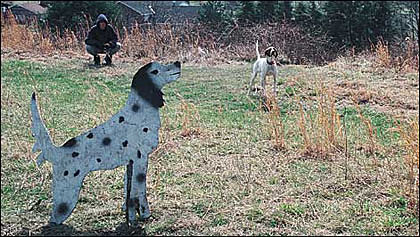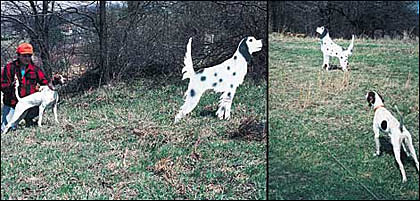How to get your dog to honor, or back, the point of another dog
By Frank Jezioro
 Set up your training site so that the dog on point (real or wooden cutout) is in place, with a pigeon in a launcher hidden in the weeds. A string to launch the pigeon has been strung back to where helper is holding the pupil. As the dog runs into the setup, the sight of the dog on point will usually slow the pupil or stop him cold, as is the case here. |
In 30 years of breeding, training, raising and hunting with pointing dogs, I've been asked a lot of questions. One of the most common questions is, "How do I get my dog to honor, or back, the point of another dog?" The following approach will answer that question for anyone with some basic training ability, patience and time.
In any training there are two fundamentals that have to be met. First, you must have it clearly established in your mind what it is that you are trying to get the dog to do. Second, you must know more than the dog. We will give you the benefit on the second by virtue of your choice of reading material.
Backing, or honoring, is another instinct of the pointing dog. The trainer simply has to reinforce it. Watch pups as they chase each other around the yard. Every now and then one will come upon his brace mate that has stopped. He too will stop for an instant before the chase is on again. Coming upon buddy who suddenly stopped "startled" him into stopping for a moment until he sized up the situation. This is the startled stop or pause that the trainer will capitalize on.
To properly train a dog you should have a controlled situation. Controlling the environment simply refers to "setting the stage" for our training sessions. Some equipment is necessary. If you have a helper and a staunch dog that will stand on point without flagging, you are all set. Or, one of the best training aids is the remote-controlled, spring-loaded silhouette. But you can use a simple plywood cutout and achieve the same result. Dogs, like people, are often intimidated by size; thus, my wooden cutout is a little larger than life size. A spring-loaded bird launcher is also very helpful. Here is how you put this equipment to use.
With the pupil ready, pick the right training location. This technique will work in a back yard or back forty--almost any location without distractions. My favorites are where a steep bank breaks onto a little flat. Another is where a brushy fence makes a corner. The corner of an old barn, garage or even the corner of a hedge will work. The idea is that you are going to set up your cutout around the corner or on top of the bank so that when the pupil comes dashing around to get to you, he will run smack into this big pointing dog frozen stiff.
Set up your silhouette out of sight of the pupil who is being held by a helper. Move around so that the pupil knows where you are and wants to come to you. Put a pigeon in your launching trap, and set it in front of the pointing dog but hidden out of sight. Also make sure you bring the backer onto the stage from an upwind position so that he doesn't get scent from the hidden bird. The backing is to be a sight-activated reaction.
Once the stage is set, move to where the pupil can see you, then walk back out of sight and into the setup. Signal your helper to release the pupil who will come rushing around the corner or up over the bank, to where he last saw you and right into the big beautiful "dog" on point. When the pupil enters the stage--as soon as you see him look at the pointing dog--throw your hand up above your head and tell him "whoa." Often, the youngster will stop for a second or two, or even go on point if he has a lot of the backing in his bloodline.
Your helper is following the check cord that the pupil is dragging, and when the pupil hesitates or stops the helper picks up the check cord and puts some tension on it. While the backing dog is concentrating on the situation with eyes fixed on the cutout, you now approach the live dog on point or wooden silhouette and begin to "handle" it as you would a real dog. Stroke his tail up while telling him "whoa" in a soft, reassuring voice.
 Working with the backing dog encourages style and intensity. Before long, the recruit will automatically stop and honor the "dog" on point when it pops up over the bank or comes around the corner. |
The tightening of the check cord on the pupil by your helper along with your saying whoa and throwing your hand up will all take place about the same instant. It isn't hard as it might sound. The throwing up of the hand comes into play later but should be done each time the backing dog comes onto the scene.
If the dog refuses to stop the first time or two, simply launch the bird, take him back to where you know he saw the pointing dog, pick him off he ground, put him down firmly and tell him what a bad dog he has been. Make him stay there while you walk out to the pointing dog. Kick the grass, stroke the dummy dog and if you haven't flushed the bird, do so now. After you have repeated this a few times you will notice that the pupil is following your every step with his eyes.
After a few days of this you will see the pupil rushing around the corner or over the bank and stopping on his own as the dog on point comes into view. But after your pupil is doing this, continue to raise your hand and handle the dummy dog.
To create or increase style and intensity you must now take it a step further. After raising your hand while saying whoa and handling the pointing dog, you will walk quietly to the backing dog with hand still held up. He may be a little uneasy at first, as he isn't sure why you are coming to him. But make him stand there and handle him now as you would if he was on point. Stroke his tail up, push his rear forward, lift and drop his hind quarters to "style him up." You want to develop a dog that backs with style and intensity, as if he were locked on point--not one that simply stops and looks around with a shepherd-like tail.
The work is not complete. Repeat until you are satisfied that he is stopping on his own when he enters the setup and sees you thrust your arm into the air. Always reward him for a good performance by flushing the bird and heaping a lot of praise on him.
Since you will be hunting in varied terrain cloaked with thick cover, you are preparing the pupil for the time when he might not know he is approaching a dog on point. So set up a scene where the pupil will come upon the trainer before he sees the backing dog. As soon as he races around the corner and spots you, thrust your arm high into the air and take a step or two toward hi
m. The usual reaction will be that he will slide into a back. If he doesn't, your helper will stop him with the check cord. Once he stops, keep your hand over your head, facing the pupil and walk towards the pointing dog that is partially hidden but still in view once you get to him. Work the pointing dog or cutout for awhile and then flush the bird. Again reward the pupil with heaps of praise when he learns to stand there.
You are preparing for the time when you are hunting and have a dog on point. The brace mate races into the situation and can't see the dog on point. You will be amazed how quickly the dogs will associate the raised hand with the dog on point and go into a rigid back.
Follow these steps and repeat them as often as needed to achieve the goal. Exercise patience, praise and understanding, and you will develop a pointing dog that you can hunt behind with pride, rather than frustration and embarrassment.






